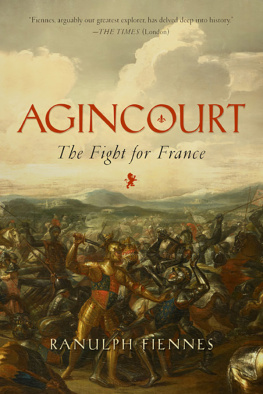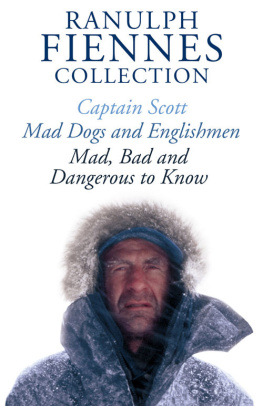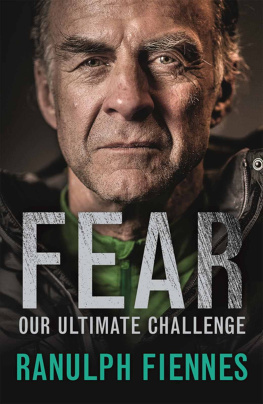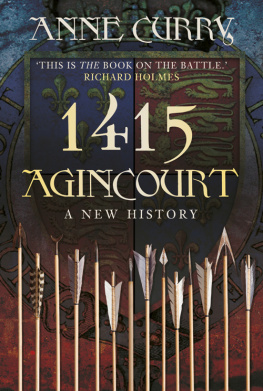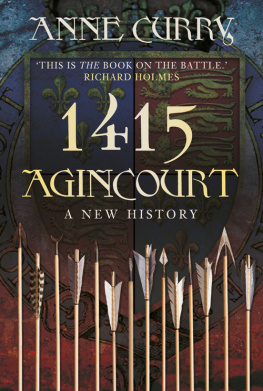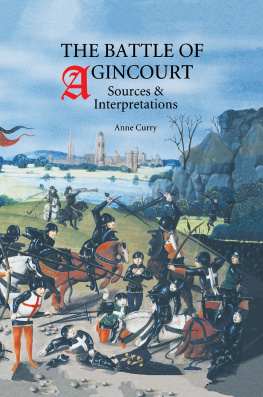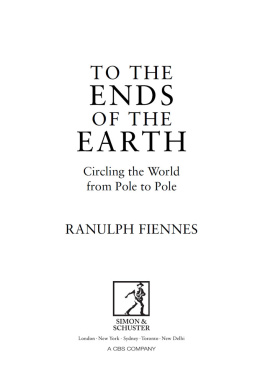

AGINCOURT
Pegasus Books LLC
80 Broad Street, 5th Floor
New York, NY 10004
Copyright 2015 by Ranulph Fiennes
First Pegasus Books hardcover edition December 2015
All rights reserved. No part of this book may be reproduced in whole or in part without
written permission from the publisher, except by reviewers who may quote brief excerpts in
connection with a review in a newspaper, magazine, or electronic publication; nor may any part
of this book be reproduced, stored in a retrieval system, or transmitted in any form or by any
means electronic, mechanical, photocopying, recording, or other, without written permission
from the publisher.
ISBN: 978-1-60598-915-0
ISBN: 978-1-60598-916-7 (e-book)
Distributed by W. W. Norton & Company, Inc.
To Anton and Jill, for the very best of friendships and for all our work together down the years.


Authors Note
To avoid using phrases like my ancestor tediously
often in the text, the names of my ancestors and their
close families are displayed in italics, for clarity.
W hile in Brussels in 2013 negotiating with Belgiums great explorer, Alain Hubert, for his help over the removal of heavy snow vehicles and my team of five men from Antarctica, his wife took me to the Central Square and showed me a magnificent statue of my ancestor, Godfrey de Bouillon, the first King of Jerusalem, and to this day a hero of the Belgian people.
On the way back to the Huberts Polar Foundation we passed along Fiennes Street, a reminder of the importance of my family in medieval times in the complex world of war between the French and the English.
Only a week later, back in England and with key Belgian support assured, I received a phone call from the editor of Hodder, part of the global French publishing group Hachette, to ask if I would be interested in writing a book about the Anglo-French Wars to coincide with the six hundredth anniversary of Agincourt, the great battle of 1415 made famous in Shakespeares Henry V.
Why me? was my immediate reaction. Surely a military historian would be a more apt choice for such a story? You, replied my editor, have the distinct advantage over most historians because of your direct Anglo-Norman ancestry whose members, during the Hundred Years War, commanded both the French and the English armies and were closely related to the kings and queens at the very nerve centre of all the Anglo-French wars. In fact it is undeniably arguable that your family members both started and later lost the war! Throughout this book I have put the names of my ancestors and their close families in italics.
So, with no polar expedition on the immediate horizon, I visited Martin Fiennes at Broughton Castle, where our family have lived since Norman times. He and his father, Nat Fiennes, the twenty-first Lord Saye and Sele, had helped me five years previously to delve into the extensive family records held in the castle attics, and at that time, although no professional archivist, I had found the study fascinating.
This opportunity to search further into the medieval Anglo-Norman wars and our familys involvement therein was, to me, a gift from the gods.
Where most historians use the term English to describe the medieval Anglo-Welsh armies, I have sometimes called them British. The various mongrel armies that opposed them across the Channel I have dubbed as either Norman or French.
In describing those bloody times when my French cousins killed their British relatives, I have tried to remain impartial not always with success.
The enmity between France and England is an ancient one that can nowadays be treated with humour. On arrival at the London 2012 Olympic Games, President Franois Hollande thanked Britain for rolling out the red carpet for French athletes to win medals. This light touch of sarcasm was doubtless in retaliation for Prime Minister Camerons earlier comment that he would roll out the red carpet for French businessmen fleeing the high rates of tax that Hollande had proposed for France. The truth is that the two countries have been jealous and suspicious of one another since the Norman Conquest of 1066, which was led by my direct ancestor Count Eustace of Boulogne, the army commander of William the Conqueror.
The series of wars involving Edward I and his successors, called the Hundred Years War by historians, was the direct outcome of the Conquerors victory at Hastings in 1066, where Eustace proudly carried the flag of the invasion. To be more specific, the Hundred Years War started as an argument between Edward III and Philip VI of France over feudal lord-ship principles, and this was caused by the fact that, after Hastings, the English (Anglo-Normans) owned huge areas of France through inheritance and/or marriage.
The war took place in two phases. Between 1337 and 1380 there was a series of invasions with the express Viking-type purpose of ravage, plunder and destruction in order to keep the French on the defensive, thereby safeguarding the Anglo-Normans possessions in France. For many years in Aquitaine and Gascony, the inhabitants preferred English rule and provided large numbers of soldiers for the English armies.
There were no standing armies in Britain until the seventeenth century, so an army had to be raised for a specific campaign, after which the soldiers would head back home with their pay and, hopefully, some worthwhile plunder, or even some ransom money.
During the 350 years between the battles of Hastings and Agincourt, the fighting skills and methods of both the two great armies underwent considerable change, as did the attitudes of their successive monarchs. So to understand Agincourt, you need to understand what leads up to it. The first chapters that follow detail the countdown to the incredible Battle of Agincourt and its aftermath.
Ranulph Fiennes

25 October 1415
B efore the cold gleam of daylight spread over the sodden trees and tents of Maisoncelles, France, King Henry V sent out orders to prepare for battle. The order for silence still held. The smell of woodsmoke as fires died down vied with the foul body odour of the soldiers scurrying through the gloom to the whispered orders of their sergeants.
Four men, all knights, were sheltered in a barn, unable to sleep. They were keen for action, any action, to break the dread anticipation of waiting for death or worse. They had all seen the horrendous wounds sustained in medieval battles. After donning their full battle armour with considerable help from their pages, they bade each other Gods blessing and went to the camps of their men.
These knights were Roger Fiennes, his brother James Fiennes, Rogers brother-in-law John Holland and Rogers stepfather John Cornwaille. All four were my direct ancestors.
If ever a single line of kinsmen had, over four centuries, a continuous influence on British history, then I claim that role for my direct ancestors and their immediate clansfolk.
Next page
